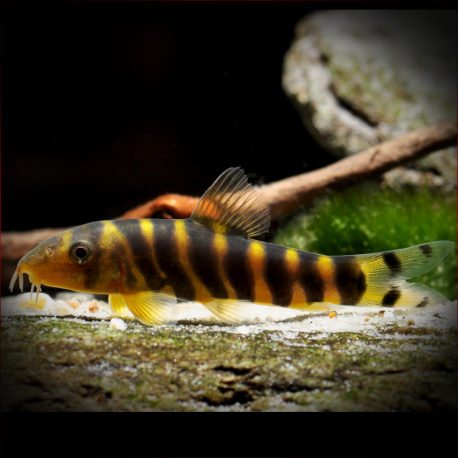More info
Datasheet
| Minimum Tank Size | 270 litres / 71.33 US gallons |
| Maximum Size | 13.0cm / 5.12inches |
| Temperature | 23°C / 73.40°F - 26°C / 78.80°F |
| Hardness | 1.01dgH / 18ppm - 10.03dgH / 179ppm |
| pH | 6.0-7.5 |
Behaviour
The Bengal Loach, also known as Botia Dario, is not particularly aggressive but should not be housed with significantly smaller species that may be intimidated by its size and active nature. Slow-moving, long-finned fish like bettas, guppies, and certain cichlids should also be avoided to prevent fin nipping. Suitable tankmates include peaceful cyprinids that dwell in open water, as well as species like Barilius, Luciosoma, Balantiocheilos, and Barbonymus in larger tanks. Botia spp. are social creatures that form complex hierarchies, requiring groupings of at least 5-6 individuals to maintain their well-being. Failure to keep them in adequate numbers can lead to aggression or withdrawal within the group.
Feeding and Diet
While primarily carnivorous, Bengal Loaches will consume vegetation if available, including soft aquatic plants. Their diet in the wild consists of aquatic mollusks, insects, worms, and other invertebrates. They should be offered a varied diet, including quality dried foods, live or frozen options like bloodworms and Artemia, along with fresh fruits and vegetables such as cucumber or melon. Chopped earthworms can be given sparingly as a protein source, and caution must be exercised as they also prey on aquatic snails.
Reproduction & Dimorphism
The Bengal Loach has not been successfully bred in captivity, although some species within the Botia genus, like B. dario, are commercially bred using hormones. Unfortunately, recent trends have seen the appearance of hybrids in the market, highlighting the challenges of proper breeding within the hobby. Sexually mature females are typically fuller-bodied compared to males, showcasing a degree of sexual dimorphism in the species.
Habitat and Distribution
The Bengal Loach is found across the Ganges and Brahmaputra river drainages in northern India, Bangladesh, and Bhutan. Their distribution extends through various states in India, reaching southern Bhutan and parts of Bangladesh. Little is known about their precise habitat, but they are presumed to be riverine and potentially migratory within their range. These loaches prefer well-structured aquarium setups with ample hiding spots and areas for exploration. Regular water changes and mature tank conditions are crucial for their well-being, as they are intolerant to organic waste accumulation and require pristine water quality to thrive.

